#late antiquity
Text

baby rattle in the shape of a dog (Athens, c. 3rd century CE)
on display at the National Archaeological Museum (Athens, Greece)
#isaac.jpg#art#archaeology#classical archaeology#greek#late antique art#late antiquity#national archaeological museum
3K notes
·
View notes
Text
JOB ALERT: MSCA-PF Joint application at the University of Granada (Spain) Department of Prehistory and Archaeology
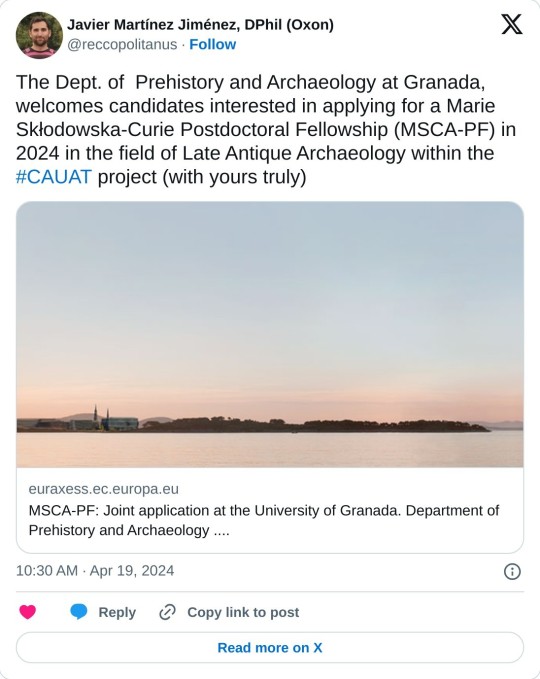
If anyone is interested in a two-year MSCA Postdoctoral Fellowship at the University of Granada within the field of late antique archaeology, please check this link with the basic information.
#Archaelogy#Acedemia#graduate job#postdoctoral job#late antiquity#if anyone applies and mentions they saw this on tumblr they'll get all my support forever
52 notes
·
View notes
Text

The Favorites of the Emperor Honorius, John William Waterhouse, 1883
#art#art history#John William Waterhouse#historical painting#ancient history#Ancient Rome#Roman Empire#Roman history#Late Roman Empire#late antiquity#Honorius#Emperor Honorius#genre painting#Pre-Raphaelite#Pre-Raphaelite Brotherhood#pre-raphaelism#British art#English art#19th century art#Victorian period#Victorian art#oil on canvas#Art Gallery of South Australia
373 notes
·
View notes
Text
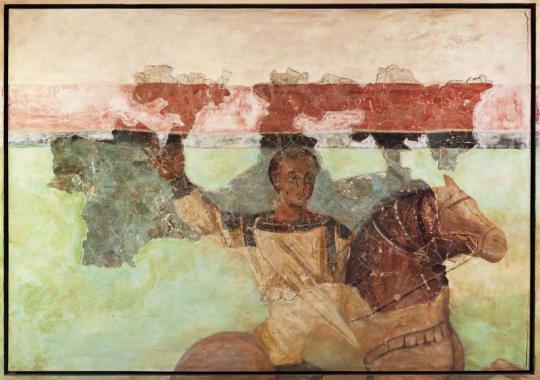

Late 4th century or 5th century (Later Roman Empire). Fresco on stucco representing a man riding a horse. Size: 80 x 160 cm.
Found in the Domus de l'Arxiu Administratiu, Barcelona, Catalonia. Nowadays in Museu d'Història de Barcelona.
#arts#arqueologia#barcelona#catalunya#late antiquity#later roman empire#roman#ancient rome#catalonia#archaeology#archeology#history#art history#travel#europe#wanderlust#fresco#painting#pintura
107 notes
·
View notes
Text

Elephants agog in the synagogue
This mosaic of a wide-eyed elephant was discovered by archaeologists in a fifth-century synagogue in Huqoq, Galilee. It is part of a scene where a white-haired Jewish leader confronts a general in Greek garb and his troops, including elephants. There has been a lot of debate about exactly who the two central figures are: was the warrior Alexander? Nero? Are they just symbolic and don't represent any particular incident? To add to the mystery, synagogues from this period rarely depicted non-Biblical events. Jodi Magness, who led the dig that uncovered the mosaic, argued that the elephants show this scene was not Biblical, since elephants do not obviously occur in the Bible (although ivory and some otherwise unidentified big beasts do crop up).
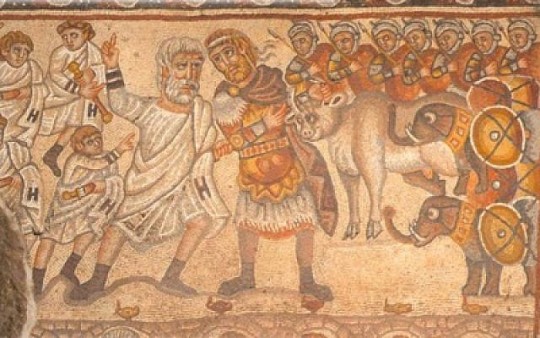
Whatever it depicts, the scene seems to suggest that there was a happy ending and that the war elephants were not deployed!
Material: mosaic
Date: late 4th or early 5th century AD
Origin: Huqoq, Galilee
Image source (x)
108 notes
·
View notes
Text
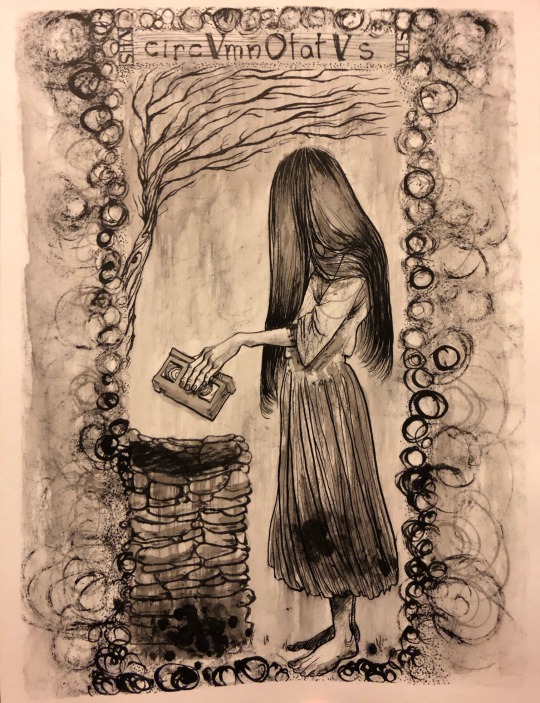

this is something i did (what feels like) a billion years ago in another life for a college art history final, the assignment was a pop culture adaptation of a work from one of the studied eras. Late Antiquity, right panel of the Symmachi–Nicomachi diptych. i remember there wasn't a good translation for the word "ring" in this context so i went with something that meant "to draw around" or "to encircle."
at the time a librarian friend asked if they could use it as promo material for their media preservation & digitization lab & of course i said yes, but i don't know if that ever panned out (i hope it did!!)
33 notes
·
View notes
Text
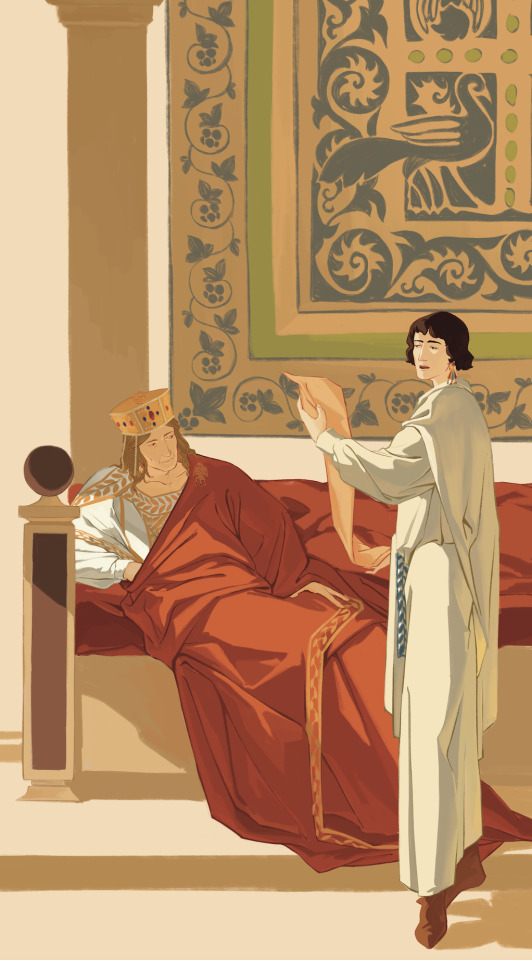
Dedication to the Princeps
fanart by @sekihamsterdiestwice
One afternoon in northern Italy around 500 A.D., the young senator Cassiodorus was sent by the Senate of Rome to the court of the Gothic king Theodoric the Great, who then ruled the whole Italy as Princeps. Performing an oration before a monarch is the best way for those young senators who aspire climb up along the cursus honorum with literary talent. In this, Cassiodorus followed what his predecessor Quintus Aurelius Symmachus had done for Emperor Valentinian I.
However, he belonged to the last generation of ancient senators who gained such reputation and prestige through Roman&secular service.
So, cherish this cozy and tranquil afternoon.
52 notes
·
View notes
Photo

Hermetica: The Ancient Greek and Latin Writings which contain Religious or Philosophic Teachings ascribed to Hermes Trismegistus
#hermetica#corpus hermeticum#hermeticism#hermetic philosophy#egyptian philosophy#greek philosophy#hermes#hermes trismegistus#mercurius#thoth#ascelipius#hellenistic#late antiquity#library of alexandria#greco-roman egypt#emerald tablet#gnosis#gnosticism
182 notes
·
View notes
Text
Coptic Women's Headpieces: padded headbands and Palmyran strips
Neither of these have much (...in the first case, any) information out there to make their own post about, but they're both interesting.

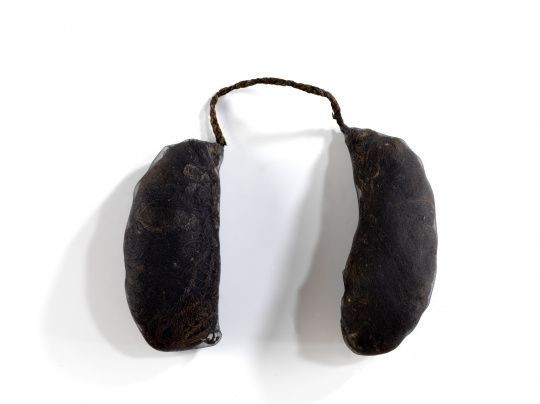
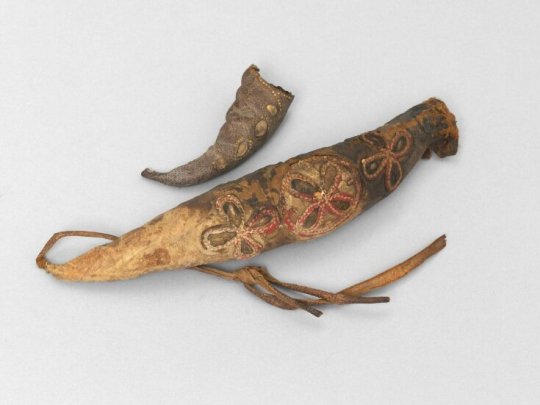

The first are these padded headpieces. In the past I'd only seen the one made of leather with flowers on it in the V&A, which notes its possible usage. However it was only until recently when I began poking around on the French internet when I found more, and better yet, an undeniable depiction of a woman wearing the headpiece. Before this I'd seen some depictions that may be the headpiece being worn, but usually seem much flatter than these were made to be or like they're a more standard gold diadem.
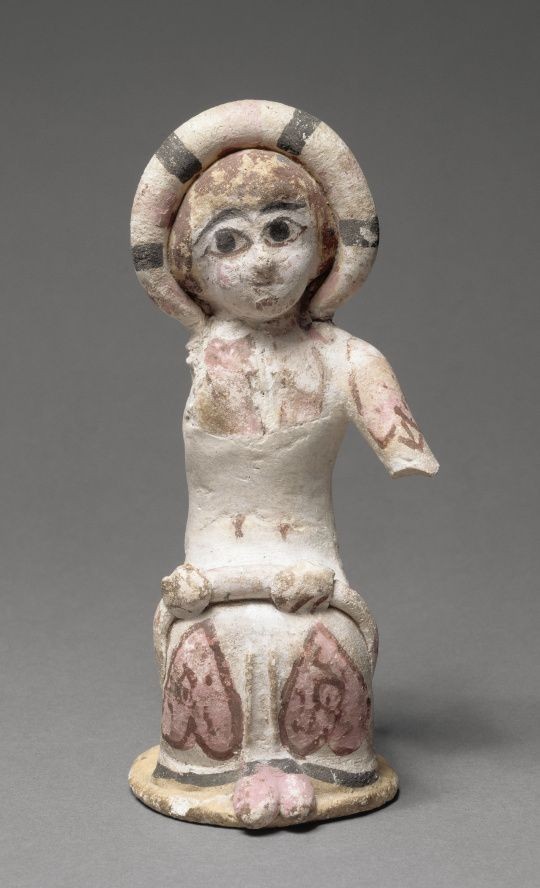
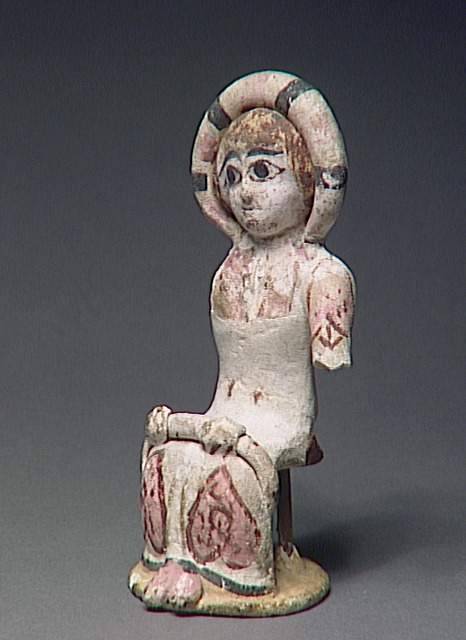
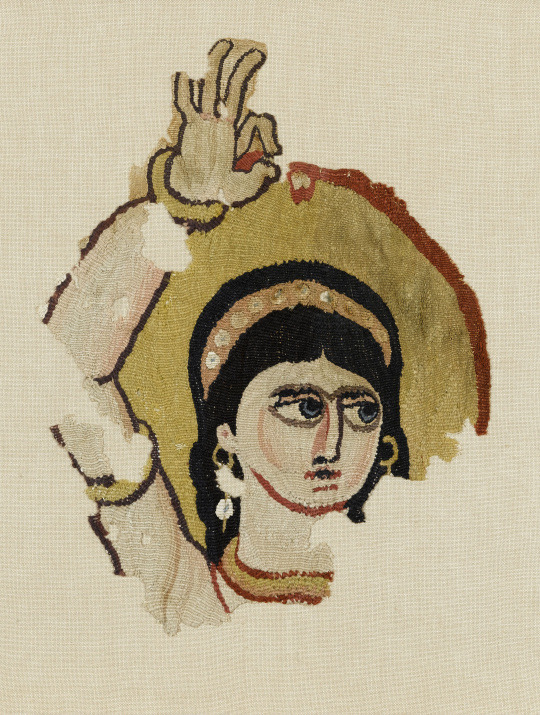
In addition to this, there are a few depictions of Coptic figures wearing these flower bud/petal crowns (more popular in the earlier part of Roman Egyptian art history), which makes me wonder if these were ever used as a base for those.


It's also possible this was out under the turbans worn by women in Coptic art. An example of a bust from Byzantine exists of a woman wearing a turban from Constantinople, and when viewed from the side it can be seen that the volume at the front of her headdress terminates in points near the nape of her neck/her ears. However, this bust also lacks the volume one would expect from the examples if a roll like the extant examples was used.
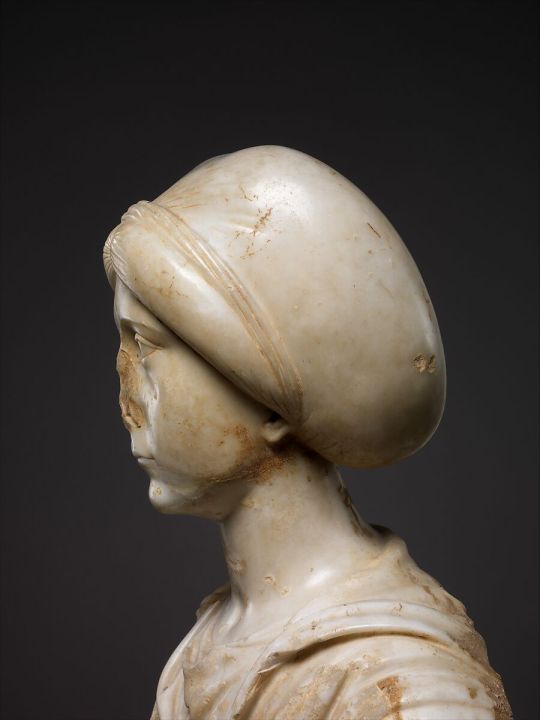
The other piece is one I noticed before, and isn't specific to Egypt, or originated from there. It seems to have come from Palmyra, and is fairly common in the funeral busts we have from there.

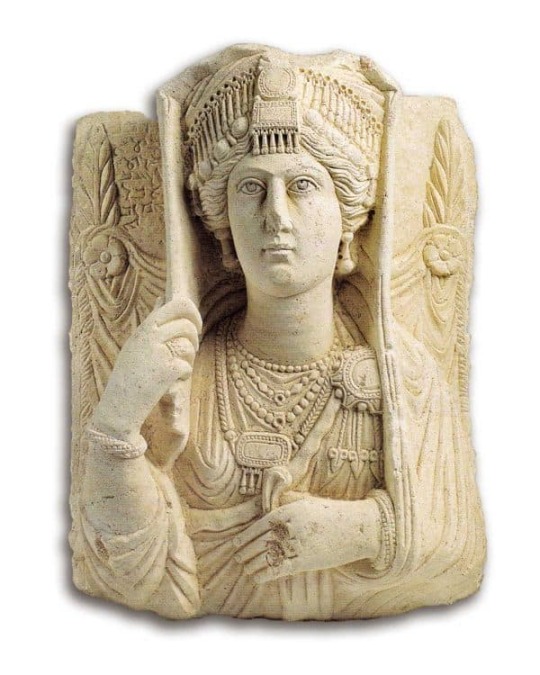
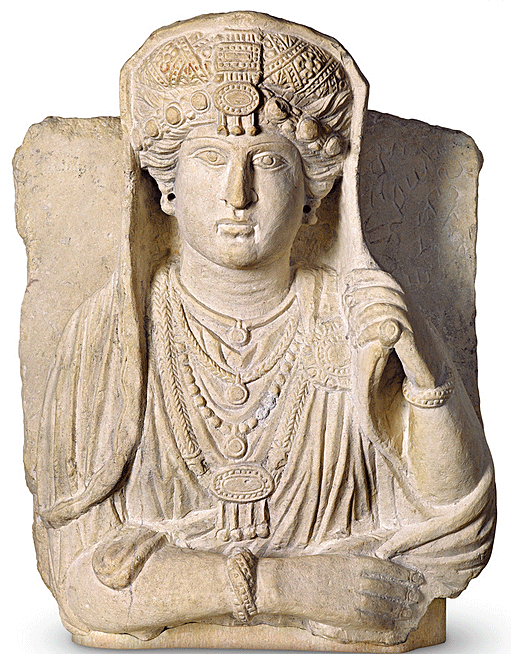
These are small plaques of metal and gems, typically with a few small beads dangling over the forehead. Currently it's supposed that they were attached to a woman's bun in some way.

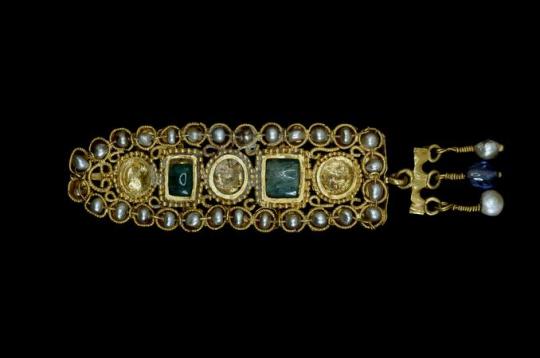
Here's a Roman-era Greek bust and a Roman- era Tunisian example.
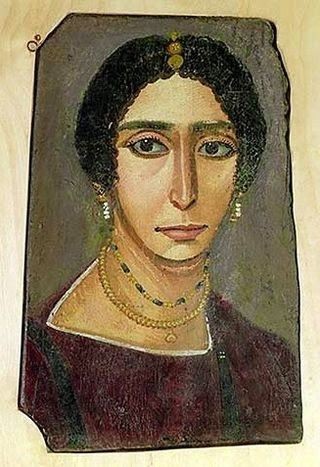
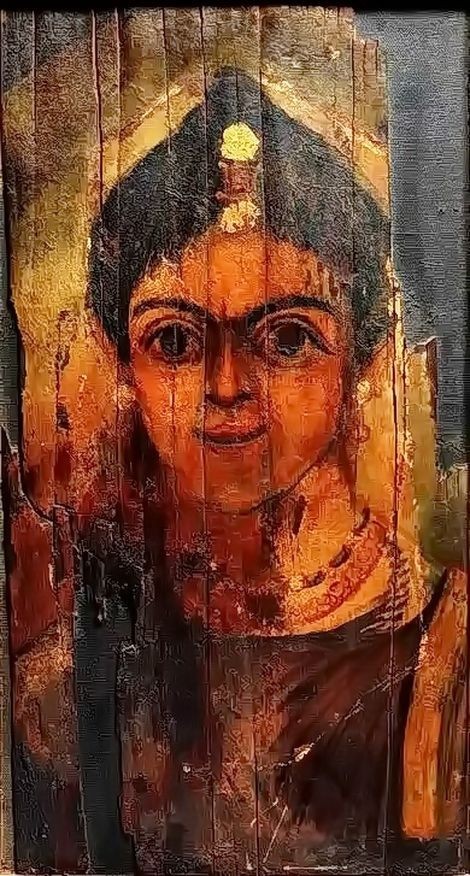



Heres some Roman-Egyptian portraits with similar head jewelry. So far, I haven't found a definitive later Coptic depiction of one being worn, but I don't think that means they stopped being worn before Christianization. It's possibly just a matter of what art has survived and what I've personally seen. Generally, Coptic jewelry is similar to the jewelry from earlier Roman-Egyptian examples, with some more unique examples and examples that were inspired by later trends in the Byzantine Empire.

One of the possible Coptic examples is from the tomb of Theodosea (full disclosure: Theodosea herself was Greek Christian living Egypt, not a Copt in the sense we mean it now, but she's dressed in a way generally common in Egypt at the time. I use "possible Coptic example" here to indicate the contemporary cultural majority of Egypt, which is distinct from the pre-Christian cultural identity of native Egyptians). Theodosea here is identified by Engy Hanna as wearing some type of golden hairnet, with a green pendant with 3 hanging pearls and two strings of hanging beads attached. Because of her palla, it's impossible to tell if she has only one medallion attached to her hairnet or if this is a strip. The overall composition of elements (a cover over the hair, the two strands, center ornament, and a shawl over top the head) are very similar to Palmyran headdresses, though she doesn't wear a turban or the patterned fillet they do.


Recently, I found a bust on an auction site labeled "Roman, probably made in Egypt" from the 1st century, with this ornament but made of a more pliable material- probably fabric. And another on the same site, maybe Egyptian (the information mentions both the terms Gandhara and Greco-Egyptian), with the more typical jeweled look, 2nd-3rd century (which is more into the swing of Christianization in Egypt).



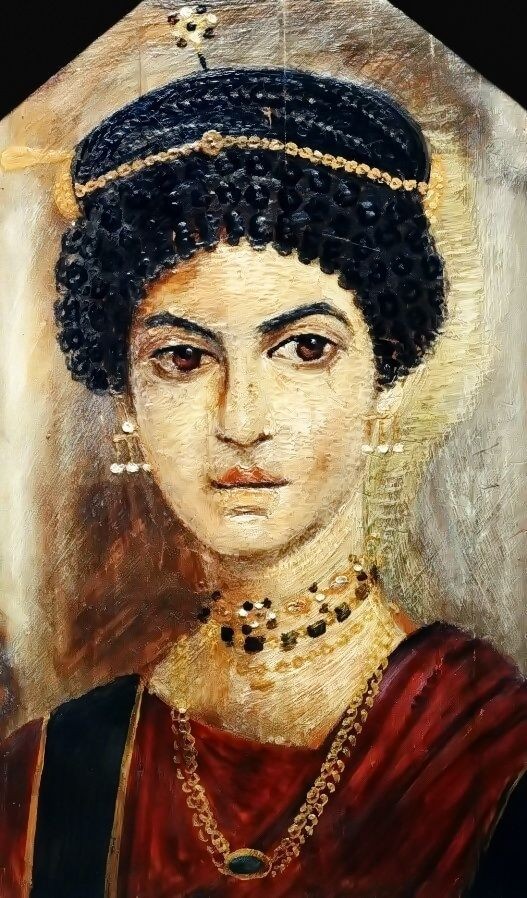

The last aside is another jewelry piece resembling that of Palmyra, though less so: a kind of circlet that appears to be made of chain with a center pendant. The star pendant worn by the second woman also notably resembles the pin holding the strip to the Greek girl's updo. The hanging strands of Theodosea are more blatant, but it's possible these were elaboration on the fashion. This style of jeweled forehead circlet, unlike the headband and strip (I have seen art of Syrian and Egyptian women with a strip, as well as Nubian art of women with a fillet/circlet and a center strip. The latter seems to be a more widely used item than the former two, which I have only seen one depiction each of so far), has remained consistently popular in West Asia and North Africa. Additionally the padded band worn by one of the Palmyran women featured here could be a related item to the padded headband; to know one would have to see the back of her head or find an artifact connecting the two. Even if a relationship can be proven between the Byzantine, Palmyran, and Coptic padded fillets, there is no clear indication of where it originated.
*I am a Copt, and if you are not, do not tag this post talking about "recreations". I find that offensive given the actions taken by Albert Gayet in regard to the clothes he took from graves. It is a simple boundary and you will not "enlighten" me to see how it's fine.*
Sources/Further reading:
https://art.rmngp.fr/fr/library/artworks/femme-assise_terre-cuite_polychromie-technique
https://art.rmngp.fr/fr/library/artworks/bourrelet-de-coiffure-postiches_laine-textile
https://art.rmngp.fr/fr/library/artworks/bourrelet-de-manteau_laine-textile
https://art.rmngp.fr/fr/library/artworks/bourrelet-de-mantelet_laine-textile_textile-matiere_lin-fibre | sources for 3 of the padded fillets and the figurine
https://collections.vam.ac.uk/item/O353014/pair-of-fillets-unknown/
https://www.metmuseum.org/art/collection/search/468716 | the marble bust
https://www.persee.fr/doc/bch_0007-4217_1969_num_93_2_4903 | in German, has photos of carvings with the hair ornament
https://www.sothebys.com/en/auctions/ecatalogue/2016/ancient-marbles-classical-sculpture-art-l16260/lot.59.html | carving of the short haired child
https://www.sothebys.com/en/buy/auction/2022/ancient-sculpture-and-works-of-art/a-roman-marble-portrait-head-of-a-girl-circa-2nd | carving of a girl with a jeweled strip, may be Egypt as the notes say an image of it was published in a work on Greco-Egyptian art and the girl has an "Isis lock" hairstyle
https://www.jstor.org/stable/4241695 | overview of Palmyran jewelry
https://www.britishmuseum.org/collection/object/G_1903-0717-3 | Tunisian example of strip
https://www.livius.org/pictures/greece/thessaloniki/thessaloniki-museum-pieces/thessaloniki-portrait-of-a-girl/
https://womenofegyptmag.com/2020/02/11/what-coptic-artefacts-tell-us-about-women-in-ancient-egypt-part-one/
#Coptic art#Coptic culture#Late Antiquity#Late Antique Egypt#Masr#Copt#Actually Egyptian tag#Cipher talk
90 notes
·
View notes
Text

A very impressive and unique tomb built by Theoderic the Great in 520 CE. He was one of the Gothic conquerors of Ravenna, Italy. His body is no longer there. It was removed by the Byzantines who conquered the city from the Goths.
#ravenna#tomb#ancient history#architecture#historical architecture#original photography#travel#archaeology#italy#theoderic the great#mausoleum#late antiquity#history#urban exploration#photographers on tumblr#lensblr#photography#taphophilia#taphophile#wanderingjana
65 notes
·
View notes
Text

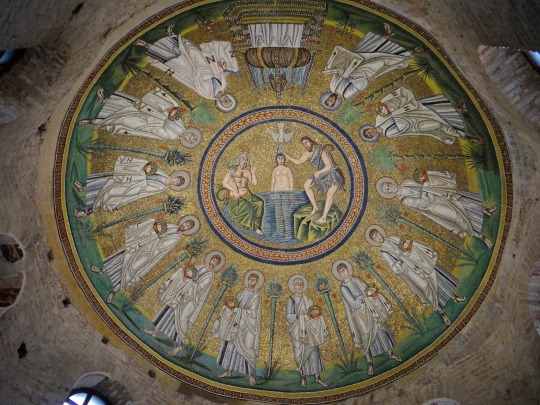
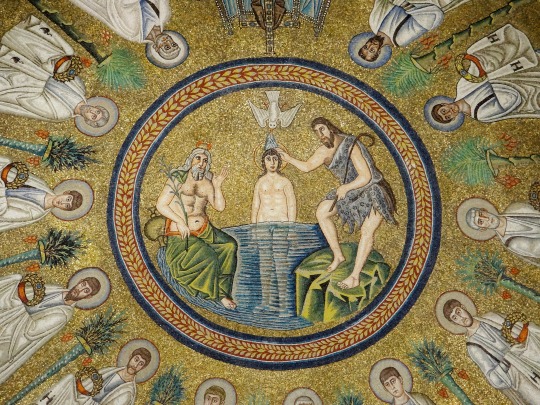
The Battistero degli Ariani (Baptistery of the Arians). It was built around the end of the 5th century by King Theodoric the Great.
Ravenna, Italy
#ravenna#italy#italia#baptistery#original photography#photography#travel#photographers on tumblr#lensblr#architecture#historical architecture#5th century#theodoric the great#ostrogoths#early christianity#late antiquity#church#church architecture#wanderingjana
23 notes
·
View notes
Text
Empress Theodora entering Hagia Soph..
oh wait, it's Alicent.
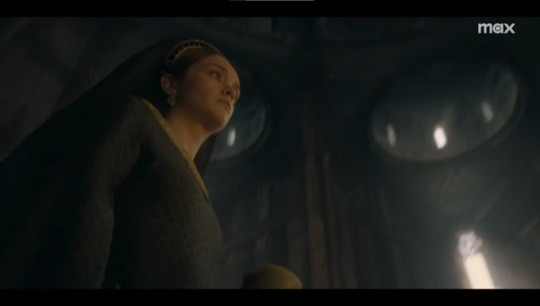
#byzantine#byzantium#game of thrones#house of the dragon#hotd#alicent hightower#rhaenyra targaryen#daemon targaryen#hagia sophia#constantinople#roman empire#late roman empire#late antiquity#house targaryen#team green#team black#hbo#hbo max#theodora#justinian#empress
21 notes
·
View notes
Text

Gold solidus of Priscus Attalus, minted in 409-10 CE. A senator from a long-standing aristocratic family who eventually became praefectus urbi (city prefect) of Rome, Attalus converted to Arian Christianity in 409 and was proclaimed emperor by the similarly Arian Visigoths, in opposition to the Catholic ruler Honorius. He would spend two brief periods in power before Honorius finally defeated and captured him in 416, leading to the last triumphal procession in the Western Roman Empire. (Two of Attalus' fingers were cut off, but he was allowed to live and banished to the Lipari Islands north of Sicily.)
On the obverse, the bust of Attalus, wearing a pearl diadem and a cuirass. On the reverse, the seated figure of Roma, holding a globe atop which Victory perches, surrounded by the inscription INVICTA ROMA AETERNA--a somewhat hollow boast, as Rome itself would be sacked by the Visigoths in 410. Photo credit:
Numismatica Ars Classica NAC AG
#classics#tagamemnon#history#ancient history#Ancient Rome#Roman Empire#Roman history#Late Roman Empire#late antiquity#art#art history#ancient art#Roman art#Ancient Roman art#Roman Imperial art#Late Roman art#late antique art#coins#ancient coins#Roman coins#Ancient Roman coins#solidus#goldwork#numismatics#ancient numismatics#Roman numismatics
43 notes
·
View notes
Photo

Santa Maria del Mar in Barcelona, Catalonia. Photo by isaura_viver on Instagram.
If you’ve been to Barcelona, you’ve most likely walked along the Born quarter (previously called la Ribera), where this square is located. But did you know that if you had visited the city centuries ago, you wouldn’t have recognised the landscape? All this area was marsh in Roman times and beach in the Early Middle Ages.
In the photo you can see the Basilica of Santa Maria del Mar (Saint Mary of the Sea), built between the years 1329 and 1383 on the location of a previous church called Santa Maria de les Arenes (Saint Mary of the Sands). The reason for that name is precisely because of its location next to the coastline, although some archaeologists and historians believe it might be because this Paleochristian church was built the location of Barcelona’s Roman amphitheatre (called Arena). The Roman city of Barcelona’s amphitheatre has never been found yet, and it was quite common for Christians to “sanctify” a Roman amphitheatre by building a church there, because Roman amphitheatres represented a place where Christians had been martyred. In the case of Santa Maria de les Arenes, it’s built on the site where the bishop Frodoí found the relics of the martyr Saint Eulàlia of Barcelona.
Archaeologists have been able to excavate a part of the church’s subsoil during a renovation, and they found many Paleochristian tombs from the Late Antiquity, between the 4th and 5th centuries. These tombs were, indeed, excavated on the beach sand. But there has not been a bigger archaeological intervention to be able to give any definitive answer about the possibility of the Roman amphitheatre to have been located there.
#barcelona#catalunya#fotografia#història#catalonia#travel photography#travel#europe#medieval#middle ages#wanderlust#explore#traveling#travelling#art history#santa maria del mar#history#arqueologia#archaeology#late antiquity
102 notes
·
View notes
Text
This might be useful for like, five other people interested in sub-Roman Britain: Been doing some quality nerd shit lately, using archaeological data to map out a rough landscape the time period a story I'm working on is set, in the 440s:





Source is Sub-Roman Britain 400-600 AD: A gazetteer of sites by Christopher A. Snyder, plus one added by me (Anderitum). Basically I summarised his entries for each of the sites and added them as annotations to his maps, but this is not a full substitute for reading it
Note that this is for Romano-British sites, noting evidence for presence of "Saxon" (a generalisation) and Irish newcomers in those, but doesn't include new settlements created by those peoples in this period
15 notes
·
View notes
Text

"In The Christianization of Knowledge in Late Antiquity, Mark Letteney offers a profoundly new and powerful analysis of late ancient intellectual life. He argues that a new model for social authority gave rise to a new form of argument, whose prestige status shaped developments across disparate fields of inquiry, from theology to law and far, far beyond. It’s a book with a thesis, and it deserves to be read and debated by anyone interested in late antiquity."
32 notes
·
View notes